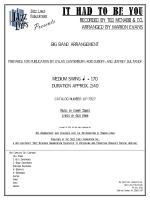IT HAD TO BE YOU
Recorded by Ted McNabb & Co.
Arranged by Marion Evans, Prepared for Publication by Dylan Canterbury, Rob DuBoff, and Jeffrey Sultanof

Cat #: JLP-7927
$65.00This item usually ships within 1 business day.
Questions?
Please call +1-518-587-1102 or email us.
Edition: Jazz Big Band Arrangement
Description: Swing - Medium Difficult
Publisher: Jazz Lines Publications
Perhaps the most fascinating thing about the 1959 Ted McNabb & Co. album is that the album's namesake was not a musician, but rather the person who financed it. McNabb's purpose was to recreate the classic sound of the big band era of the 1930s and 40s, albeit with a twist of post-bebop modernism thrown in for good measure. By hiring a lineup of top New York City studio musicians (many of whom were Swing Era vets) to perform and arranger Marion Evans to craft the charts, McNabb was able to accomplish this goal and then some.
Evans' take on It Had to Be You is taken at a quicker pace than usual, turning what is typically a ballad into a gently swinging medium-fast feel. The introduction sees the brass playing some simple hits around a few weaving saxophone lines before taking over the first part of the melody at measure 9. The A sections of the melody are structured in a conventional call-and-response fashion between the muted brass and saxes, with the saxes handling a slightly modified version of the melody on the B sections.
Following this is a chorus of Urbie Green on trombone, with some simple sax backgrounds as the only accompaniment. The full ensemble returns for a shout chorus at the pickups to measure 73, where the key bumps up a minor third. Although the volume picks up here, your ensemble should continue to maintain the relaxed, easy swinging feel that has been the hallmark of the rest of the arrangement to this point. Evans' shout chorus effectively functions as a variation on the original melody, never straying too far away while still not being a direct copy from before. The ending sees the brass and saxes trade over a tagged final few bars, with the brass playing an unaccompanied syncopated figure before the saxes and rhythm join them for the concluding hold.
This publication was based on the original Marion Evans score and the set of parts used for the 1959 recording session - this is not a transcription.
2 Alto Saxophones
2 Tenor Saxophones
Baritone Saxophone
4 Trumpets
4 Trombones
Guitar
Piano
Bass
Drums
Trombone 1: Bb4
Trombone 2: C5








